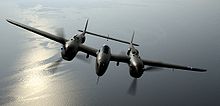Well, I found some of the potential changes in the fuel system. It appears the Outer Wing tanks were only factory installed after the J-10 and there is evidence in the pilot manuals that some of these airplanes were field modified by their addition. You can see that in the change in the Auxiliary Fuel Pump switch box photos (which I can't seem to upload right now). Initially, the P-38 had a four position fuel valve selector: MAIN - RES - DROP TANK - OFF; and two booster pump control switches (L and R) with ON/OFF positions. Cross-suction was handled via a separate crossfeed valve with its own control, apart from the selector valves and aux. control box. Some of these aircraft with the 4-position valves show a replacement of the old two-switch aux. control box to a four-switch box: two booster pump (ON-OFF) switches, and two Wing Tank switches (ON-OFF). This means that the wing tanks weren't integrated into the fuel selector valves from the factory but were controlled using their own booster pumps which fed directly to the engine(s)--which is why cross-feed wasn't available for them.
Later aircraft, those equipped with the Wing Tanks from the factory, integrated both the wing tank selection and crossfeed to a five position fuel selector (DROP TANK and OFF were combined into the same position). Even of these there are two variants: "early" models, with the traditional fuel booster system but including a OW Fuel Level test light on the box; and "modified" models with a fully pressurized fuel system using submerged booster pumps in each tank--these had four switches on the aux. control box but they were Boost Pump Master Switches (ON-OFF) and Boost Pump Emergency switches (ON-OFF). In all, that four different fuel management set-ups / fuel systems all applicable in various production blocks and modifications from the J through the end of production in the L.
Apart from the changes required to install and accommodate the Aileron Boosters and Dive Flaps (likely several modifications required for each), the afore mentioned improved Turbo Regulators, and these fuel system changes other possible modifications that may have been included could be the simplified Bomb/Drop Tank/Rocket control box (with the associated auxiliary control switches added to the yoke) and whatever modification Tony mentioned in the video to help with the detonation issue.
That last I find curious as I can't figure out field modifications they would have put in place for that since, from my understanding, that was solved with a manifold redesign by Allison...but I could be wrong there.
The other consideration--that of having all these modification kits on a single plane--is likewise unsolved. It is possible that 1) portions of the modification kits were sent separately, which could explain the existence of aircraft with the four-position fuel selectors and aux. Wing Tank selectors; 2) most of the parts required for the modifications were quite small and light (or were simply templates/instructions on how to modify parts already installed); and 3) there weren't 500 kits, as Tony said in the video, but instead only 200 kits as I've seen mentioned in various other sources.
Later aircraft, those equipped with the Wing Tanks from the factory, integrated both the wing tank selection and crossfeed to a five position fuel selector (DROP TANK and OFF were combined into the same position). Even of these there are two variants: "early" models, with the traditional fuel booster system but including a OW Fuel Level test light on the box; and "modified" models with a fully pressurized fuel system using submerged booster pumps in each tank--these had four switches on the aux. control box but they were Boost Pump Master Switches (ON-OFF) and Boost Pump Emergency switches (ON-OFF). In all, that four different fuel management set-ups / fuel systems all applicable in various production blocks and modifications from the J through the end of production in the L.
Apart from the changes required to install and accommodate the Aileron Boosters and Dive Flaps (likely several modifications required for each), the afore mentioned improved Turbo Regulators, and these fuel system changes other possible modifications that may have been included could be the simplified Bomb/Drop Tank/Rocket control box (with the associated auxiliary control switches added to the yoke) and whatever modification Tony mentioned in the video to help with the detonation issue.
That last I find curious as I can't figure out field modifications they would have put in place for that since, from my understanding, that was solved with a manifold redesign by Allison...but I could be wrong there.
The other consideration--that of having all these modification kits on a single plane--is likewise unsolved. It is possible that 1) portions of the modification kits were sent separately, which could explain the existence of aircraft with the four-position fuel selectors and aux. Wing Tank selectors; 2) most of the parts required for the modifications were quite small and light (or were simply templates/instructions on how to modify parts already installed); and 3) there weren't 500 kits, as Tony said in the video, but instead only 200 kits as I've seen mentioned in various other sources.



